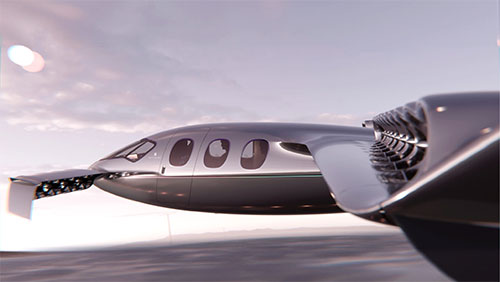
From Wikipedia: The idiom “jumping the shark” or “jump the shark” is a term that is used to argue that a creative work or entity has reached a point in which it has exhausted its core intent and is introducing new ideas that are discordant with, or an extreme exaggeration of, its original purpose.
Welcome to https://siriusjet.com/
This is a project that combines several aspects of physics that are best left alone. I had thought that these types of projects had gone the way of Milli Vanilli and Moonboots but this looks like a fresh one.
Where does one start?
Powertrain
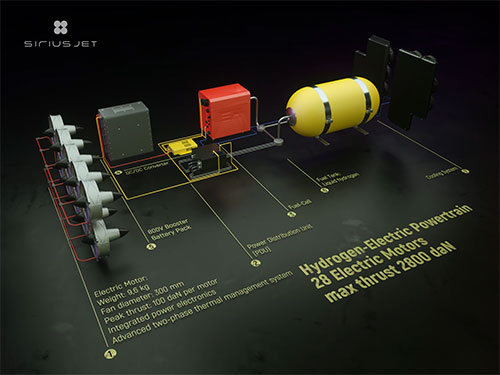
On their powertrain graphic, they claim to carry a tank of liquid hydrogen and to do this they will have a proprietary cooling system.
I like their bold mastery of physics. Carrying liquid hydrogen means that you swap the problem of storing at thousands of psi with storing at a very low temperature.
It also means that in order to maintain your hydrogen in a liquid state you need to consume power in order to operate the cooling system. Whenever people talk about hydrogen storage I go to this diagram:
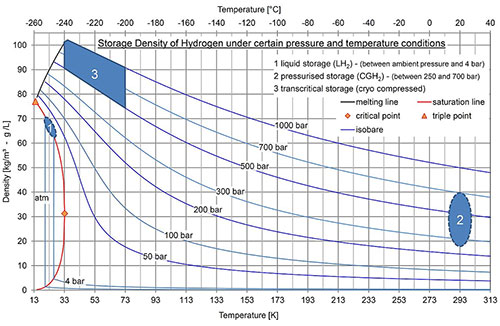
This tells you that to keep hydrogen in a liquid state it has to be at around 20Kelvin, or -253C. Looking online for cryogenic cooling systems, I could not find a system that does not rely on an existing external source of liquid nitrogen. So let’s pretend that they have a system that can keep their tank at -253C without the need for an external source of liquid nitrogen and that it is reliable and light enough to put in an aircraft and let’s pretend it is both cost and energy-effective.
(Side note, with liquid hydrogen you can’t just park up, put the handbrake on, and walk away. If your cooling system is not running continually your hydrogen will turn to gas with the inevitable increase in pressure and will exit your storage system either through a pressure relief valve or by more kinetic means. This means that you have to run your cryogenic cooling system when you are parked on the ground in midsummer in Riyadh, fighting the 40C heat, creating a required temperature differential of 293C)
You also have to have access to a source of liquid hydrogen and a way to get it from where you think it might be (tank or truck) into the fuel tank in the aircraft. Let’s pretend that those problems have been solved and there is a low-cost readily available source of liquid hydrogen and a means to get it from ground storage to your aircraft.
Figuring out MTOW
Let’s look at some other metrics – they have 28 electric motors that weigh 9.6kg each and produce 100daN on thrust each, that is 225lb of thrust in real money. Each fan has a 300mm diameter.
So we can quickly work out that the maximum thrust is 225 x 28 = 6300lb. So assuming that they have a 1.5 thrust margin to nominal 1g thrust, their MTOW should be around 4200lb.
Power Requirement
When I want to look at disk loading I go to this graph:
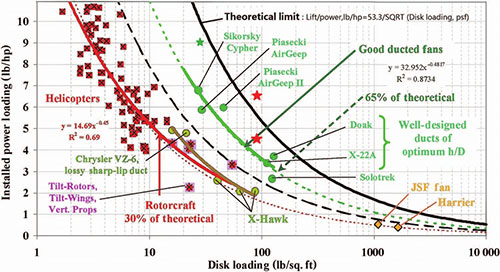
The Sirius has a disk loading of around 190 (nominal) – 290 (peak) lb/sqft, using the graph above that puts them higher than is optimum and at an installed power loading (for good ducted fans) of around 2 – 2.5lb per HP.
Doing the simple math means that the power system needs to generate between 1.25 (nominal) to 2.3 (peak) MW or 1680 to 3150HP.
This compares to Lilium’s peak power requirement of 2.2MW so we are in the right ballpark.
Cruise Performance
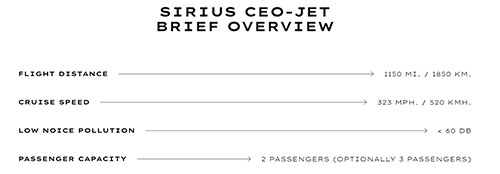
We will overlook the misspelling of ‘noise’, I have made enough spelling mistakes of my own… cruising for 1150miles at 323 MPH gives a cruise endurance 3.5 Hours.
If they have a cruise L/D of 10 (Lilium claim a cruise L/D of 18, but let’s be real. Their peak L/D may be higher but high speed cruise L/D is never at the peak value).
Their power consumption in cruise flight will be 1.25MW / 10 = 125KW or 168HP.
When I want to look at Gravimetric density and Volumetric density I use this graph:
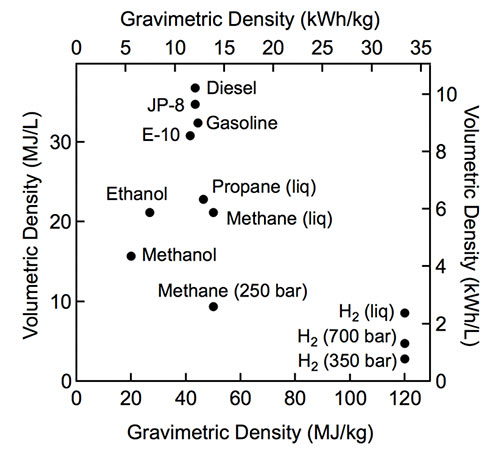
So cruising at 125KW for 3.5 hours. that is 438kWh.
Now we can work out the weight and size of the Hydrogen tank.
Liquid Hydrogen has a gravimetric density of around 32 kWh/kg, so assuming 100% efficiency you need around 14kg of Hydrogen. But let’s assume some powertrain inefficiencies: We will assume the combination of fan, wiring, controller, fuel cell, etc then you have a combined inefficiency of 75% – you need 18kg or 40lb of Hydrogen. Then you have to add the weight of the tank, the insulation and the cooling system – let’s say a total of 100lb
Similarly, the volume required will be around 250L or 50 Gallons.
Hovering Performance
For take-off and landing the vehicle will use batteries – the power required for take-off and landing we can assume to run at an average of 1.2 x one g of thrust. That is 1.5MW.
The Hydrogen power system will contribute the cruise power it is sized for, which is .125MW, this leaves 1.375MW to come from batteries.
If we assume take off and landing (and potential aborted landing, hold, and go around) lasts for 10 minutes that is 1375 x 10/60 = 230Kwh. We had to add some inefficiency and batteries to motors are better without a fuel cell so lets assume 80% overall efficiency 230 / 0.8 = 287.5Kwh.
Good installed battery energy density = 200Wh/kg.
The mass of batteries needed = 287,500/200 = 1438kg or 3162lb of batteries. Or 75% of MTOW.
Realistically this vehicle will only be able to hover (and maneuver while in hover) for less than a minute.
And, bear in mind that we are not considering any reserve requirements in the above calculation.
System Weights
So the total eight of the powertrain and fuel will be something like:
Fans (28 x 9.6 x 2.2) = 592lb
Fuel and Tank = 100lb
Batteries = 3162lb
Estimate for Wiring, power electronics and all the other stuff = 100lb
Total weight of powertrain and fuel = 592 + 100 + 3162 + 100 = 3954lb
Which is very close to our MTOW of 4200lb.
That is a no go.
Summary
In essence, this project has taken all of the impracticality, complexity and performance issues of the Lilium jet and has compounded them with the addition of a cryogenic storage hydrogen power storage system.
Maybe the founders of this program have just not been watching the eVTOL sector, the high consumption of investment for little progress, the immaturity of type and operation regulations, the lack of air traffic and power infrastructure, and the bored indifference of the traveling public outside of a small group of manic cheerleaders.
Nice website, shame about the aircraft.
Comment On This Post